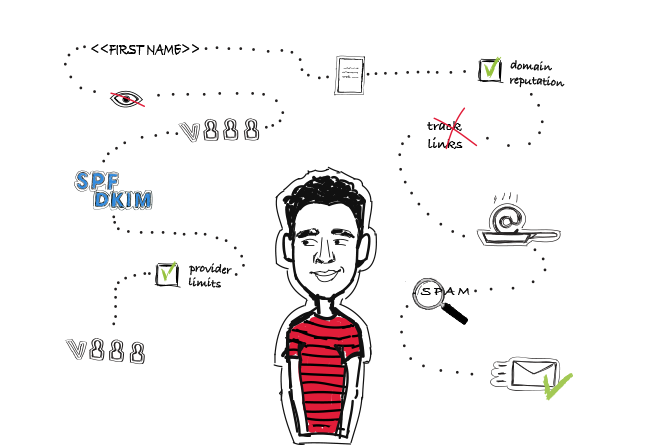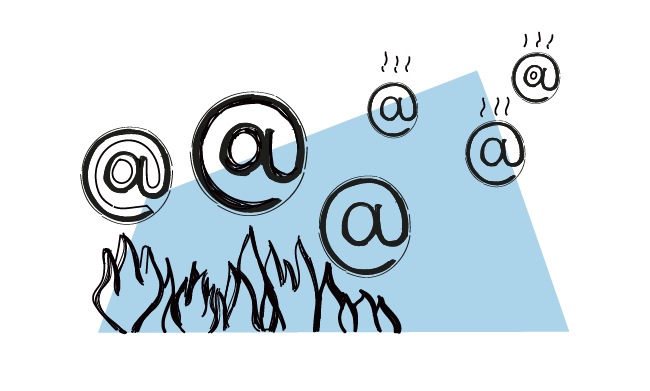Here’s the scenario. You only recently started with Woodpecker but you already see the massive potential you’ve unlocked with cold emailing. After a bit of experimenting and browsing through our massive library of guides and other helpful resources, you’re comfortable with the basics of good subject lines and persuasive content and maybe you’ve even mastered the concept of ready-made email sequences.
In short, you’re ready to go and can’t wait to get your message out to the world with tons of emails that will result in tons of leads.
And that’s why we want to have a word with you first.
Because there are some very important things you should know about before you start knocking on all those virtual doors on your long list of contacts. Things that can ruin all of your outreach if you ignore them. Things that can ruin not just your current campaign, but future ones as well.
We’re talking about technical measures implemented by all email service providers that, if you cross certain lines, can severely limit the one email metric that controls all the others — deliverability.
Prospects can’t read what they never get
Deliverability is something that often gets overlooked because it’s taken for granted. You sent a mail so that means the recipient got it, right? It can’t just disappear into space, can it?
Well, in fact it can. We don’t mean literally disappear, of course, but it’s important to remember that there are other places an email can land besides your primary target — recipient inboxes. You already know about the spam folder but most major email service providers also have “Promotions” or “Offers” tabs, where they direct messages of a commercial nature or emails with sender origins that are known to be “spammy”.
It may not seem like it because occasionally an unwanted message lands in everyone’s inbox, but email service providers are extremely effective at blocking the massive amount of unsolicited commercial messages sent through their networks.
The tools they use to accomplish this are needed to maintain a high user experience and protect accounts from those who abuse email through huge numbers of emails sent without the consent of the recipient.
What is Woodpecker’s sending algorithm?
We all enjoy the benefits of this hardline approach that email services providers have to take — nobody wants their inbox to be flooded daily with commercial offers. The downside is that you can get caught in these safety measures meant to protect users even if you have no bad intentions.
The email service providers have to rely on a kind of profiling to determine if you are a trustworthy sender or not. If you get too close to the gray area associated with a “bad” profile, your messages are unlikely to ever see an inbox again.
Every email address and every domain has a “reputation” in the eyes of email service providers and, just like your own reputation, it’s based on past behavior. Preserving and protecting your sender reputation is the most important thing you can do to maintain a high deliverability rate.
After all, it doesn’t matter how good your offer is or how convincing your message is if your prospect never sees it.
What is Bounce Shield?
It’s all about avoiding getting blocked by your provider (which would stop your sending for the entire day) and giving you a better chance of having and keeping a good reputation as a sender.
Going slow is the way to go
Let’s make one thing clear before we look at how to scale up your cold email campaigns:
There is no shortcut to being able to send large volumes of emails. The sender reputation that you need to do this takes time and attention to build.
In practice, this almost always means taking things slowly. As a rule of thumb, following the process in a way that will ensure optimal performance takes about three months. This process is called warming up your domain.
We understand that this can be frustrating at first and you want to hurry up and move things along. But rushing into it by sending more emails, often more than your email service provider thinks you should send, will only result in one thing getting done quickly — your sending reputation getting ruined to the point where no one will get your messages.
If you want to scale up your cold emailing activities, be sure to follow some basic tips regarding:
Sending limits
This is a no-brainer. If you want to tell the world that you’re sending spam, send tons of messages in one day. The numbers can vary from one email service provider to another but the point is that there is a limit on how many mails you can send every day. Consistently staying within the limit (and taking a break from sending when you get close) is a must for warming up an inbox and domain.
You can use your settings to change the number of emails sent in a day. We do not recommend exceeding an absolute maximum of 200-300 cold emails sent daily.
Sending intervals
How often you send cold emails matters too. And even without seeing the content, you could guess that emails sent from the same address every few seconds would look suspicious — who sends “normal” emails that fast?
That’s why it’s important to space them out and not set off alarms. Our sending algorithms make sure there is a natural break between sent emails, usually from at least 90 to 140 seconds. That means that you can send a maximum of about 30 emails per hour from a particular address (those leftover seconds are used to do things like verify the validity of the recipient address).
Also, it’s good to space your emails out over time but not in a rigid, scheduled way. Think of the natural rhythms established by the normal process of trading emails with someone. The time that passes between replies varies and so should the time between emails in your campaigns.
Prospect lists
When your mail “bounces”, it’s often because the address isn’t valid. A high number of bounces tells email service providers that you’re not very careful about whom you send your messages to – a huge red flag for them. Verify the quality of your contact list before adding it to your campaign.
Creating & sending from multiple new accounts at the same time
Again, what could look more “spammy” than this? It looks like a deliberate effort to get around daily sending limits or just get as many emails out there before you get banned.
It doesn’t matter if that’s not really your intention, because that’s how it looks. The lesson here is that each individual address and domain has to go through its own warm-up process. Remember — no shortcuts.
What is Woodpecker Warm-up & Recovery?
Warming up first avoids problems later
Go to any gym and you’ll see people stretching and loosening up before hitting the weights or joining an aerobics class. Why? Because it’s better to get your body ready for high-energy effort with small warm-up exercises that get the blood flowing and muscles ready to work first.
Skip this part and you’re risking pain or injury because you tried to go from zero to a full-on workout without first reaching a middle stage.
The same idea applies to cold emailing. You can’t go from zero to 100% straightaway, you have to build up through intermediary stages first. Moving gradually at first enables you to move (almost) as fast as you want later.
Skip this part and you’re risking a different kind of pain — seeing all your effort result in no leads because you triggered the anti-spam measures that directed your messages to places where they are unlikely to ever be seen.
Warm up your inbox and domain slowly in the short term to create the long-term trust that will make your cold mailing even more effective.
What is Woodpecker Inbox Rotation?
This is a new Woodpecker feature designed to help you avoid sending pauses caused by exceeding sending limits or problems with your mailbox that can occur on the go. Thanks to advanced algorithms it allows you to rotate multiple mailboxes within a campaign to keep your deliverability high and ensure smooth sending. Incredibly helpful when one of the mailboxes goes belly up and needs to be fixed.
How? You can add as many mailboxes as you want and send your campaign from multiple email accounts to improve deliverability. If one of your mailboxes within the campaign has errors, the system gives option to easily assign your prospects to other mailboxes that are already attached to your campaign. This way, sending goes smoothly and without interruptions. See how to send from multiple accounts in Woodpecker.
FAQ
What is a cold email marketing software and how can it benefit my sales team?
Cold email marketing software is a tool designed to assist sales teams in automating and managing their cold emailing campaigns. By using such software, sales teams can streamline their sales process, personalize email campaigns, and effectively engage potential clients through targeted outreach.
How does a free trial for cold email software work?
A free trial for cold email software typically allows users to test the full range of features offered by the software for a limited period. This includes capabilities like mail merge, email validation, and automated follow-ups, enabling users to evaluate the software’s effectiveness in their cold email campaigns.
Can cold email tools integrate with my Gmail account?
Yes, many cold email tools offer seamless integration with Gmail accounts, allowing users to send personalized outreach emails directly from their email account. This integration simplifies the process of managing cold email campaigns across multiple channels.
What features should I look for in the best cold email software?
When searching for the best cold email software, look for features like email validation, the ability to automate follow-ups, A/B testing, and support for unlimited email accounts. These features are crucial for running effective cold email outreach campaigns.
How can a sales engagement platform enhance cold emailing?
A sales engagement platform enhances cold emailing by providing a multi-channel approach to outreach. It allows sales teams to coordinate email campaigns with other channels, ensuring a more comprehensive and effective engagement strategy.
What are the benefits of using a cold email outreach tool for personalized email campaigns?
Using a cold email outreach tool for personalized email campaigns offers the benefit of tailoring messages to specific audiences, increasing the likelihood of engagement. These tools often include features like mail merge and automated personalization, making it easier to connect with recipients on a more personal level.
How does email validation work in cold emailing software?
Email validation in cold emailing software works by verifying email addresses before sending out campaigns. This process ensures that emails are sent to valid, active email accounts, thereby improving deliverability and the overall effectiveness of the email campaigns.
Can cold email outreach software automate follow-ups?
Yes, many cold email outreach software options include the capability to automate follow-ups. This feature allows sales teams to schedule a series of follow-up emails, ensuring consistent engagement with potential clients without manual intervention.
What is the role of A/B testing in cold email campaigns?
A/B testing in cold email campaigns plays a crucial role in optimizing email content and strategies. By testing different versions of emails, sales teams can determine which elements resonate best with their audience, leading to higher engagement rates.
How can I manage multiple channels in my cold email outreach?
To manage multiple channels in your cold email outreach, look for a cold outreach tool that supports multi-channel coordination. This allows you to synchronize your cold email efforts with other outreach methods, creating a cohesive and effective sales engagement strategy.
What pricing models are common for cold email outreach tools?
Pricing models for cold email outreach tools often vary, with some offering a per-user subscription while others provide tiered plans based on features or the volume of emails. It’s important to consider the scale of your campaigns and the specific needs of your sales team when choosing a plan.
READ ALSO

14 Deliverability Checks to Carry Out Before Sending Your Cold Email Campaign
You can have control over your cold email deliverability. In outbound outreach, it's crucial how many of the emails you sent actually get to your prospects' inboxes. There are at least 14 points on a deliverability checklist that you can, and should, go through before you start off your email campaign. I've listed them below in three categories. Some of them you may already know of, but some may be new for you. Check the list and see if you're doing everything you can to ensure that your cold emails actually get to their destination.

8 Best Cold Email Warm-up Tools in 2025
Have you ever wondered if every email you send from your mailbox will be successfully delivered? If you want to avoid the SPAM folders and land your cold emails in your prospects main inboxes, this article is just for you.

Woodpecker Warm-up & Recovery: Warm up Mailboxes and Domains Automatically
We’ve just launched an email warm-up and recovery feature - included in price for all our premium users.

